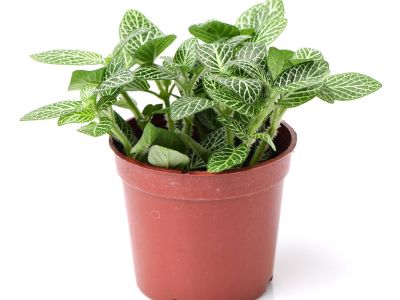Fittonia Nerve Houseplants
The nerve plant, or Fittonia argyroneura, from the Acanthaceae (Acanthus) family, is a tropically found plant with striking leaves of pink and green, white and green, or green and red. Foliage is primarily olive green with veining taking on the alternate hue. For specific color characteristics, look for other Fittonia nerve houseplants, such as F. argyroneura with silver-white veins or F. pearcei, the carmine pink-veined beauty. Named for its 19th-century discoverers, the botanists Elizabeth and Sarah May Fitton, the Fittonia nerve plant does indeed flower. The blooms are insignificant reddish to white spikes and tend to blend in with the remainder of the foliage. The blooms of the nerve plant are rarely seen when it is grown indoors as a houseplant. Hailing from Peru and other areas of the South American rain forest, this colorful houseplant craves high humidity but not too much irrigation. This little beauty does well in terrariums, hanging baskets, dish gardens, or even as a ground cover in the right climate. The foliage is low-growing and trailing with oval-shaped leaves on rooting, mat-forming stems. To propagate the plant, these rooted stem pieces may be divided or tip cuttings may be taken to create new Fittonia nerve houseplants.
Nerve Plant Care
As the nerve plant originates in a tropical setting, it flourishes within a high humidity environment. Misting may be required to maintain humid-like conditions. Fittonia nerve plant likes well-drained moist soil, but not too wet. Water moderately and let growing nerve plants dry out between waterings. Use room temperature water on the plant to avoid shock. Growing about 3 to 6 inches (7.5-15 cm.) by 12 to 18 inches (30-45.5 cm.) or longer, the Fittonia nerve plant tolerates bright light to shade conditions but will truly flourish with bright, indirect light. Low light exposure will cause these plants to revert to green, losing the vein’s vibrant splashes of color. Growing nerve plants should be placed in a warm area, avoiding drafts that will shock the plant just as water that is too cold or hot. Think about rain forest conditions and treat your Fittonia nerve houseplants accordingly. Feed as recommended for tropical houseplants per the instructions of your fertilizer brand. The trailing nature of the plant can lead to a straggly appearance. Prune the tips of the nerve plant to create a bushier plant.
Nerve Plant Problems
Nerve plant problems are few; however, as mentioned above, avoid overwatering as this can lead to root rot. Xanthomonas leaf spot, which causes necropsy of the veins, and mosaic virus may also affect the plant. Pests may include aphids, mealybugs, and thrips.
